Storm photography can be an exciting and rewarding experience, allowing you to capture dramatic weather events and showcase nature’s power. However, photographing storms can also be dangerous, with hazards such as lightning strikes, strong winds, and flying debris. That’s why it’s crucial to prioritize safety when capturing weather and to be prepared for emergencies with a well-stocked first aid kit.
First aid kits can provide essential medical supplies and equipment to help treat injuries and manage emergencies. Whether you’re a professional storm chaser, or an amateur photographer, having a first aid kit on hand can be the difference between a minor injury and a life-threatening situation.
Key Takeaways:
- Storm photography can be hazardous and requires prioritizing safety
- Carrying a well-stocked first aid kit is crucial for managing emergencies and treating injuries
- Professional and amateur photographers alike can benefit from having a first aid kit on hand
Weather Photography Equipment: Essential Gear for Safety
When it comes to storm photography, having the right equipment is crucial to ensuring your safety in potentially dangerous weather conditions. Here are some essential items that every storm photographer should consider:
| Equipment | Description |
|---|---|
| Weatherproof Camera | A camera that can handle rain, wind, and other harsh weather conditions is a must-have for storm photography. Look for a camera that is durable and waterproof, so you can capture the shot without worrying about your camera getting damaged. |
| Sturdy Tripod | Wind and rain can make it difficult to keep your camera stable while shooting. A sturdy tripod can help keep your camera steady, allowing you to capture great shots without worrying about your camera getting knocked over by the wind. |
| Waterproof Clothing | When it comes to storm photography, you need to be prepared to get wet. A good set of waterproof clothing, including a jacket and pants, can help keep you dry and comfortable while you shoot. |
| Protective Eyewear | Wind and debris can cause eye injuries during storm photography. Make sure to wear protective eyewear, such as safety glasses, to protect your eyes from potential hazards. |
| Reflective Vest | If you plan on shooting during low light conditions, a reflective vest can help make you more visible to others around you and keep you safe from oncoming traffic. |
Investing in quality weather photography equipment can make a big difference in your safety and the quality of your photos. Make sure to do your research and choose gear that is appropriate for the specific weather conditions you plan on shooting in.

First Aid Essentials for Storm Photographers: Be Prepared for Emergencies
When it comes to storm photography safety, it’s essential to have adequate emergency supplies on hand. As a storm chaser, you are faced with unpredictable weather conditions and various hazards that can put your well-being at risk. Having a well-stocked first aid kit is crucial to help you deal with injuries and emergencies.
Here are some first aid essentials for storm chasers to include in their emergency supplies:
| Item | Purpose |
|---|---|
| Adhesive bandages | To cover minor cuts and wounds |
| Antiseptic wipes | To clean and disinfect wounds |
| Sterile dressings | To protect and cover larger injuries |
| Tweezers | To remove splinters or debris from injuries |
| Pain relief medication | To manage pain caused by injuries or illnesses |
These essential supplies should be kept in a waterproof container or bag that is easily accessible in case of an emergency. It is also important to keep a first aid manual or guide on hand to help you handle different types of injuries and emergencies.
Being prepared with the right emergency supplies can help you feel more confident and safer when pursuing storm photography. Make sure to check and restock your emergency kit regularly, especially before heading out to capture storms.
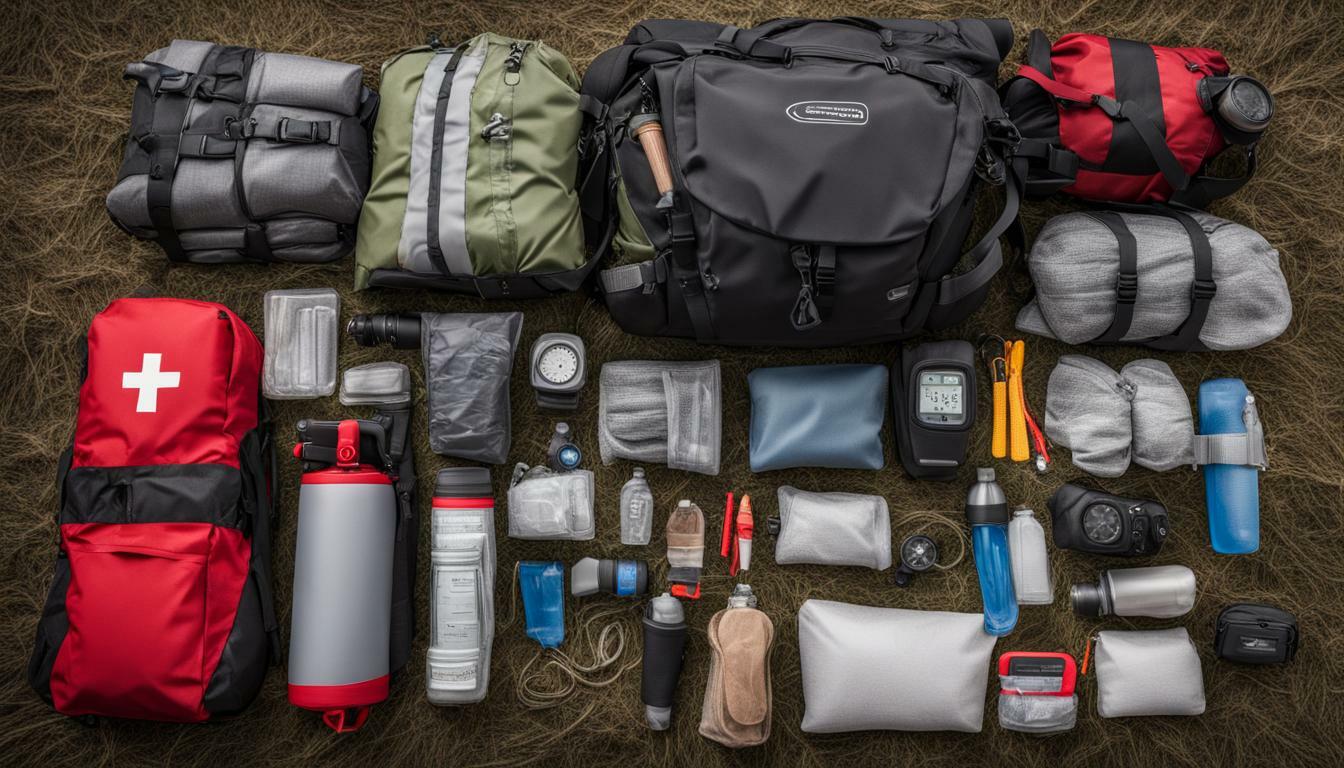
Protecting Yourself: Safety Gear for Storm Photography
Storm photography is an exhilarating experience, but it can also be dangerous. Protecting yourself from the elements is crucial to staying safe while capturing your shots. Here are some essential pieces of storm photography protective equipment and safety gear for storm photographers:
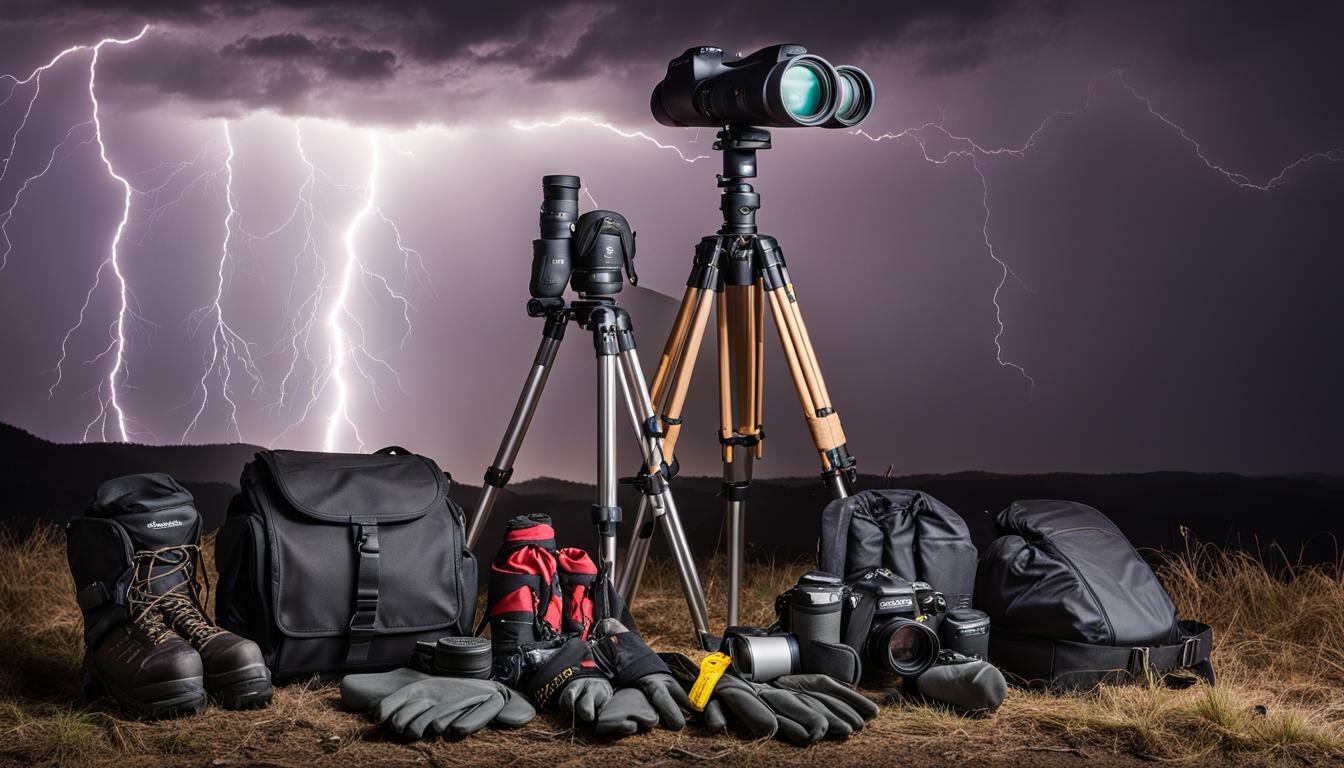
Helmets
A helmet can provide essential protection against falling debris and head injuries. Look for a helmet that fits well and has a chin strap to keep it securely in place. Choose one that is lightweight and comfortable to wear for extended periods.
Gloves
Sturdy gloves are crucial for protecting your hands from cuts, scrapes, and other injuries. Choose gloves that are waterproof and offer a good grip, to keep your camera and other equipment securely in your hands.
Reflective Vests
A reflective vest is an important piece of protective gear, especially when shooting at night or near roadways. The vest will make you more visible to drivers and help prevent accidents. Look for one that is adjustable and comfortable to wear over your clothing.
Remember, safety should always come first when it comes to storm photography. Using protective gear like helmets, gloves, and reflective vests can help keep you safe and allow you to capture incredible shots with confidence.
Setting Up a Weather Photography Emergency Kit
As a storm photographer, it is important to be prepared for emergencies. One way to ensure your safety is to create a comprehensive weather photography emergency kit. Here are the steps to follow:
Step 1: Find a suitable container
You will need a waterproof and durable container for your emergency kit. A medium-sized backpack or a waterproof duffel bag would be ideal.
Step 2: Include a first aid manual
Make sure to include a first aid manual in your kit. This will help you to know how to treat common injuries such as cuts, sprains and heat exhaustion.
Step 3: Add emergency contact information
Include a list of emergency contacts such as local hospitals and ambulance services in case of an emergency.
Step 4: Pack emergency blankets
Emergency blankets will help you to keep warm in extreme temperatures and protect you from hypothermia in case of prolonged exposure to cold weather.
Step 5: Waterproof bags or containers
Pack waterproof bags or containers to protect your gear from water damage in case of unexpected rain or storms.
Step 6: Include a whistle
A whistle can be used to signal for help in case of an emergency or if you get lost.
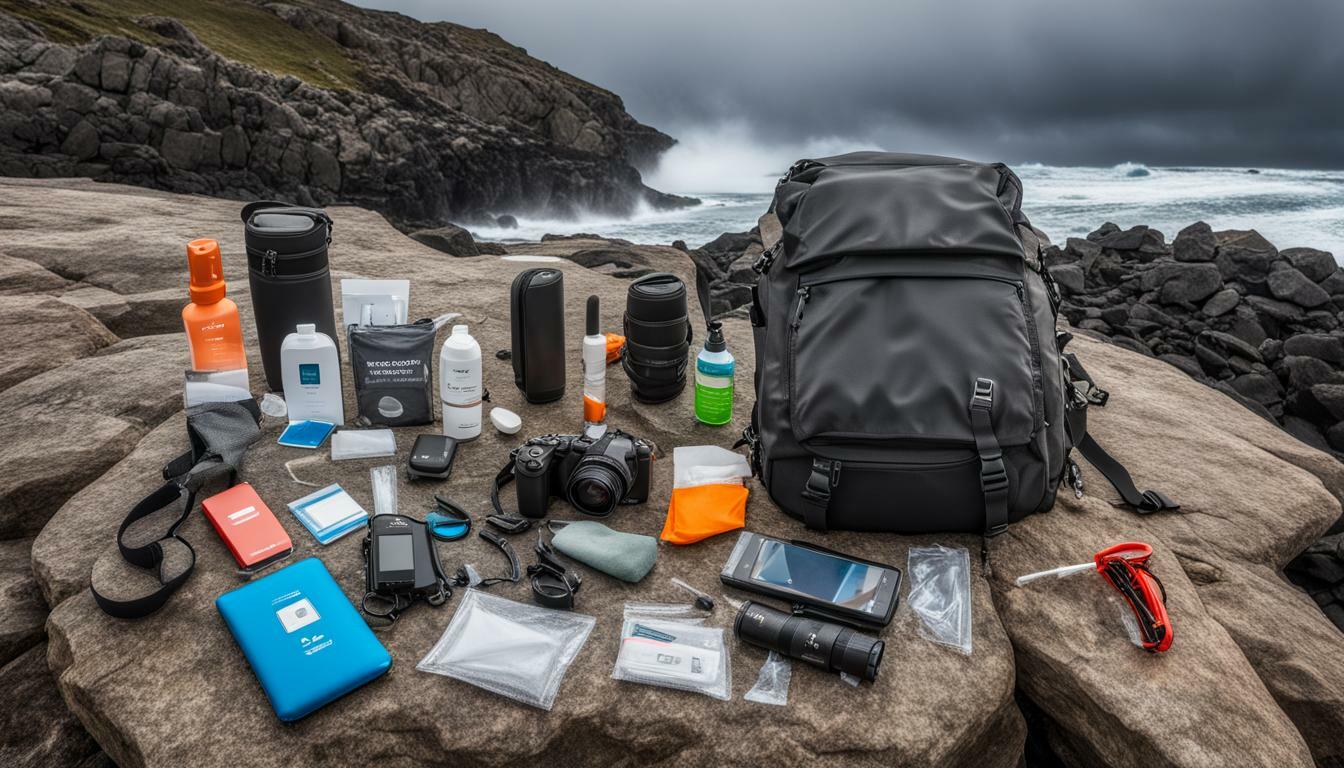
By following these steps, you can set up a comprehensive weather photography emergency kit. Remember, safety should always be a top priority when capturing weather and storm photography.
Staying Informed: Weather Forecasting Resources
Staying informed about weather conditions is essential for storm photographers to ensure their safety. There are a variety of online resources and weather apps that can help photographers track and anticipate severe weather events.
One useful resource is the National Weather Service, which provides up-to-date information on weather conditions throughout the United Kingdom. The Met Office also offers a range of services, including detailed weather forecasts, radar and satellite imagery, and severe weather warnings.
For photographers who want real-time updates on storm activity, the Lightning Maps website offers a live map of lightning strikes as they occur. Other apps and websites, such as Storm Radar and Weather Underground, provide detailed information on storm tracks, wind speed and direction, and precipitation data.
It’s important to note that weather forecasting is not always accurate, and conditions can change quickly. For this reason, it’s essential for storm photographers to have the right weather photography gear and be prepared for unexpected changes in weather conditions.

By staying informed and properly equipped, storm photographers can capture stunning images of severe weather while staying safe and protecting their gear.
Safety Tips for Storm Photographers: Best Practices
Storm photography can be an incredible and thrilling experience, but it can also be dangerous if proper safety precautions are not taken. To ensure you are capturing weather safely, consider these practical safety tips:
1. Stay informed
Before heading out to capture storms, take the time to check weather forecasts and track storms using online resources or weather apps. Keep an eye on changing weather patterns and be prepared to adjust your plans accordingly.
2. Maintain a safe distance
It’s important to keep a safe distance from the storm to avoid getting caught in dangerous weather conditions. Be aware of your surroundings and the potential risks posed by falling debris and high winds. If in doubt, err on the side of caution and move to a safer location.
3. Seek shelter when necessary
If the weather becomes too severe or dangerous, seek shelter immediately. This could mean taking cover in a nearby building or vehicle, or simply moving to a safer location until the storm passes.
4. Use protective gear
Wear appropriate protective gear such as helmets, gloves, and reflective vests to protect yourself from flying debris, extreme temperatures, and other hazards encountered during storm photography. Additionally, consider investing in weatherproof cameras, sturdy tripods, waterproof clothing, and protective eyewear to ensure your gear is up to the task.
5. Know when to stop shooting
While it may be tempting to keep capturing photos of an approaching storm, it’s important to recognize when it’s time to stop shooting due to safety concerns. Keep an eye on changing weather conditions and be prepared to move to a safer location if necessary.
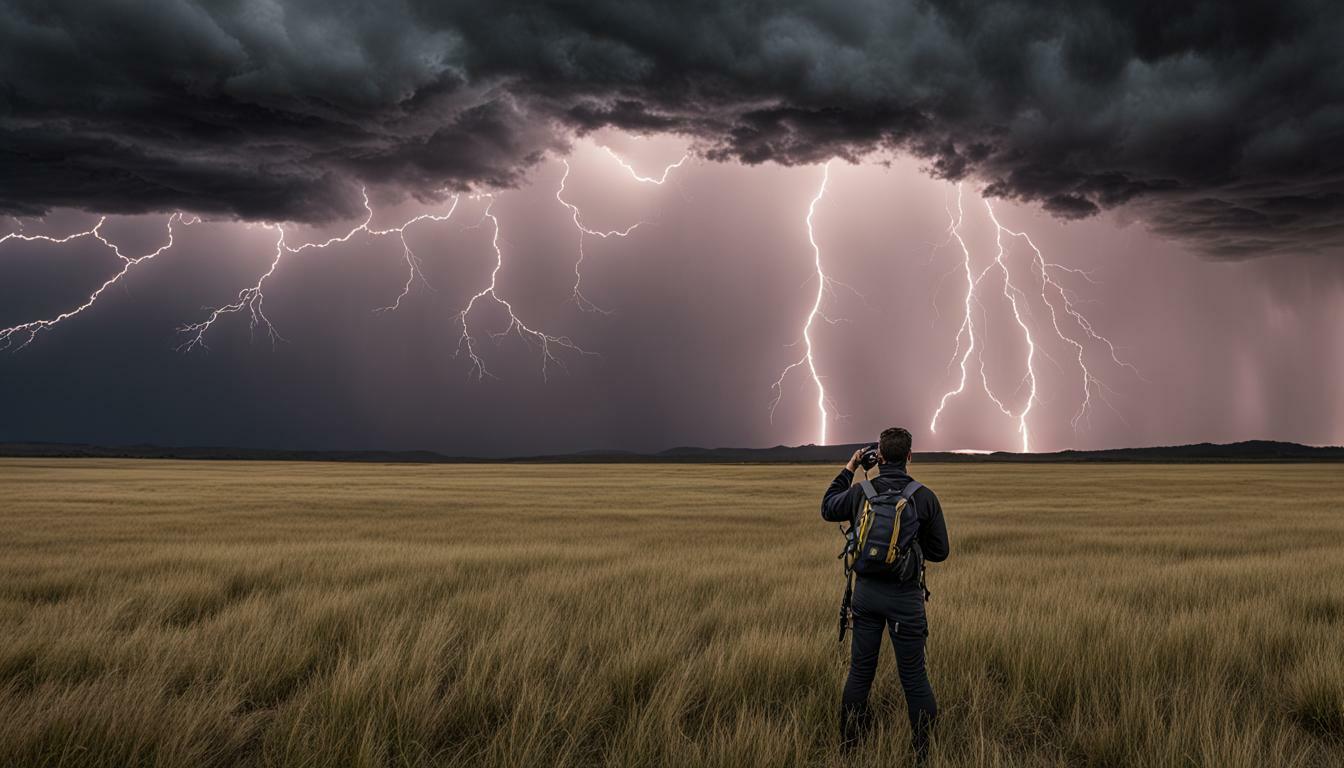
6. Develop a personal safety plan
In addition to carrying a first aid kit and emergency supplies, it’s important to have a personal safety plan in place. This could include communication protocols, designated meeting points, and emergency evacuation routes in case of severe weather conditions or injuries.
By following these safety tips and being prepared for emergencies, you can enjoy the thrills of storm photography while keeping yourself and others safe. Remember, capturing weather safely should always be the top priority for any storm photographer.
Emergency Preparedness: Developing a Personal Safety Plan
To ensure storm photography safety, developing a personal safety plan is crucial. This plan should include communication protocols, designated meeting points, and emergency evacuation routes.
Firstly, establish a communication plan with your team or fellow photographers before setting out to capture weather. Make sure everyone has a way to communicate with each other during an emergency.
Designated meeting points are essential to ensure that everyone is accounted for and safe. Choose easily identifiable locations and make sure everyone in your group knows where they are.
In case of an evacuation, it is important to have a clear and easy-to-follow emergency evacuation plan. Make sure everyone knows what to do and where to go. Run through the plan before starting any photography activities.
Remember, taking safety measures before capturing weather is crucial for storm photography safety. A well-thought-out personal safety plan can ensure that everyone stays safe and secure.
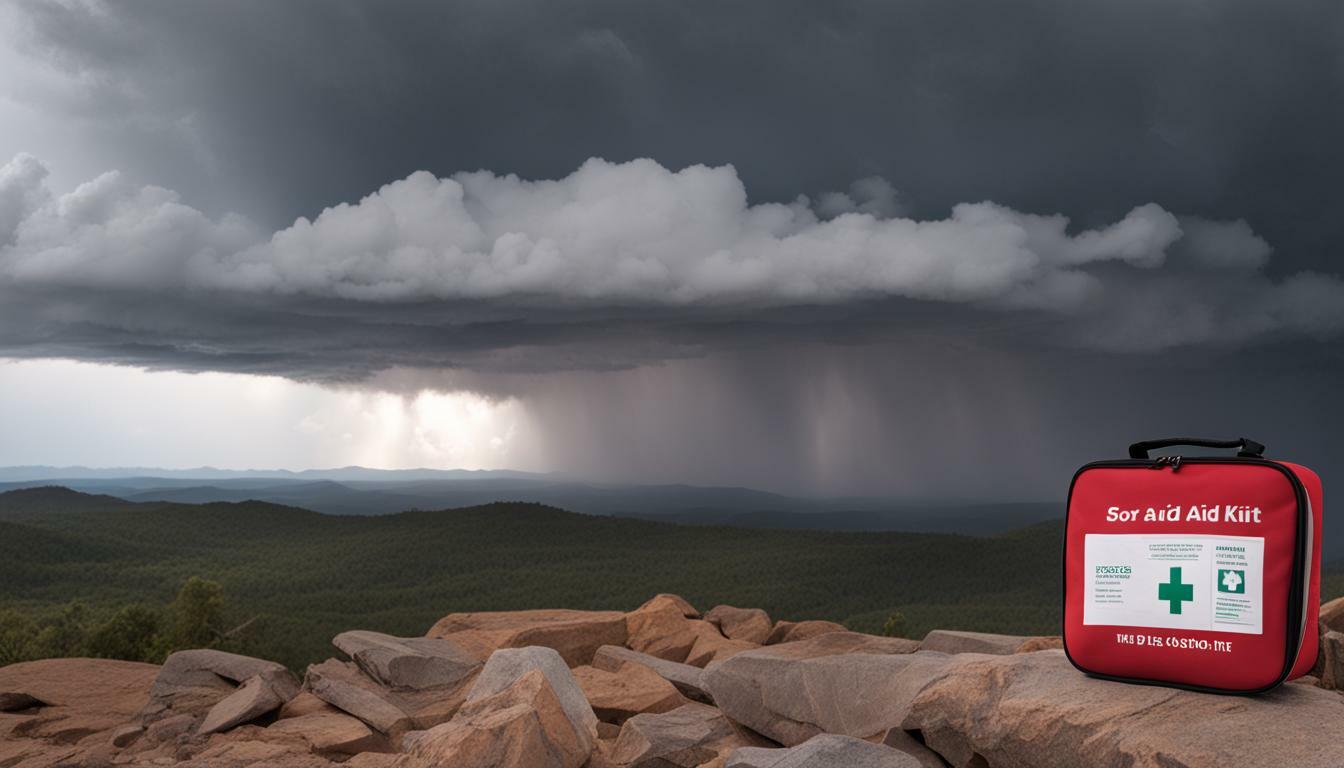
Storm photography safety and capturing weather safely are essential for any weather photographer. Therefore, it is crucial to have a personal safety plan in place before setting out to capture stunning and daring weather photographs.
Dealing with Injuries: First Aid Techniques for Storm Photographers
While capturing the perfect storm shot, storm photographers are exposed to various risks, including injuries. In case of an emergency, it is crucial to be equipped with essentials in your first aid kit. Here are some first aid tips for storm photographers to handle common injuries:
- Cuts and wounds: Wounds can be easily caused by flying debris and sharp objects. If it is a minor cut or wound, disinfect the area, apply pressure on the wound with a clean cloth, and cover it with a sterile dressing. If the cut is deep and bleeding uncontrollably, immediately call for professional medical help.
- Sprains and strains: Uneven terrains and slippery surfaces can lead to sprains and strains. In case of muscle injury, follow the RICE method- Rest, Ice, Compression, and Elevation. If the pain persists, seek professional medical help as soon as possible.
- Heat exhaustion or hypothermia: Storm photographers are exposed to extreme temperatures- heat or cold. Symptoms of heat exhaustion can be dehydration, weakness, and nausea, while hypothermia symptoms include shivering, confusion and fatigue. In either case, it is crucial to seek shelter and rehydrate immediately. In severe cases, it is essential to contact professional medical help.
It is crucial to remember that any injury needs immediate attention and care. Being prepared for emergencies with the right first aid kit and appropriate precautions can help minimize the risk of injury and ensure a safe storm photography experience.

The Importance of Self-Care: Mental and Emotional Well-being
While capturing weather can be an exhilarating experience, it can also be physically and mentally challenging. Storm photography often involves long hours in extreme weather conditions, which can take a toll on a photographer’s well-being. Therefore, it is crucial to prioritize mental and emotional self-care while engaging in storm photography to ensure capturing weather safely.
One way to promote mental and emotional well-being is to manage stress effectively. Stress management techniques such as deep breathing, meditation, or yoga can help calm the mind and reduce tension. It’s also essential to take breaks and rest when needed. Overworking or pushing oneself too hard can lead to exhaustion and burnout.
Another way to support mental and emotional health is to seek support from fellow photographers or professionals. Joining a community of like-minded individuals can offer a sense of camaraderie and provide opportunities for learning and growth. Professional counseling or therapy can also help manage stress or address underlying mental health issues.
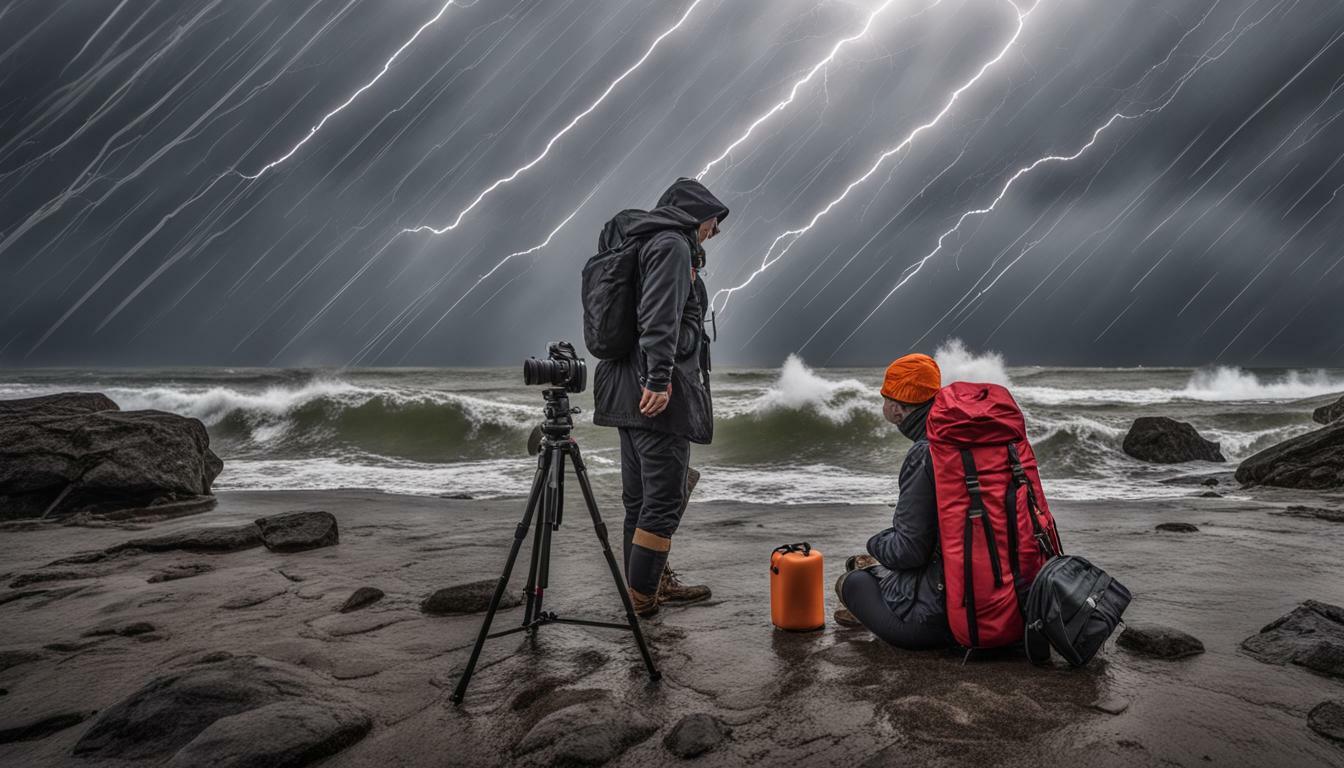
Practicing self-care during and after challenging storm photography experiences is also essential. This can include getting adequate rest, staying hydrated, and maintaining a healthy diet. Engaging in hobbies or activities outside of photography can also help recharge and maintain perspective.
However, if stress or anxiety persists, seeking medical attention is necessary. A professional can provide guidance or medication to manage symptoms effectively. It’s essential to prioritize mental and emotional well-being to keep enjoying the exhilarating experience of capturing extreme weather safely.
Conclusion
Overall, storm photography can be an exhilarating and rewarding experience, but it is important to prioritize safety and preparedness. By carrying a well-stocked first aid kit, investing in appropriate safety gear, and staying informed about weather forecasts and best practices, storm photographers can greatly reduce the risks involved in capturing severe weather events.
It is also important to remember the value of self-care, both during and after storm photography experiences. Taking time to manage stress, seek support when needed, and prioritize mental and emotional well-being can help photographers maintain a healthy balance and continue their passion for capturing weather safely.
We hope that this guide has provided useful information and guidance for those interested in storm photography. Remember to always prioritize safety and preparedness, and enjoy the thrill of capturing the power and beauty of nature!
